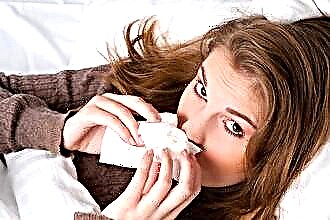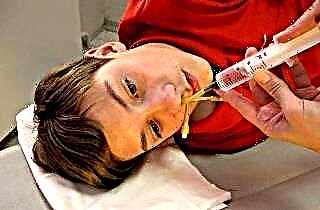- catarrhal;
- hyperplastic (hypertrophic);
- atrophic.

Acute catarrhal laryngitis is the most typical development of the situation with a viral or bacterial lesion. It occurs as an independent disease, or more often it is one of the symptoms of measles, whooping cough, scarlet fever, respiratory infections, especially if they are caused by the flu or parainfluenza.
This form of laryngitis is most typical in childhood. For the adult population, the most typical chronic course of the disease, in which the symptoms are present for more than three weeks.
Clinical signs
The clinical picture in this case is due to the development of an inflammatory process in the mucous membrane of the larynx or its individual structures. It is the vocal cords that are the part of the larynx that can be affected in isolation. The development of inflammation is expressed by hyperemia and thickening of the ligaments, which prevents them from tightly closing during phonation.
The main symptom present with local lesion of the ligaments is a violation of the timbre of the voice.
He becomes rude, there is a rapid fatigue from the conversation, manifested by the transition to a whispering speech. Acute catarrhal laryngitis can be characterized by diffuse lesions. In this case, the entire mucous membrane of the larynx is exposed to the inflammatory process. The symptomatology is more pronounced. In addition to a qualitative change in the voice, the obligatory symptoms are:
- dry cough;
- sore throat, scratching;
- sore throat when swallowing.
The general condition may not be disturbed, but more often there is an increase in body temperature up to 37.3-37.4 degrees, weakness, fatigue.
Chronic catarrhal laryngitis is characterized by thickening of the larynx mucosa. However, it retains the usual pale pink color. Hyperemia of the mucous membrane appears only during the period of exacerbation of the disease. The vocal folds are also somewhat thickened, blood vessels are visible in their thickness.
Inflammation of the vocal cords leads to their incomplete closure during phonation. The glottis remains ajar. As a result, the patient complains of constant hoarseness, a sore throat. A dry cough or a constant urge to clear your throat is a constant sign. The cough is intermittent, in some cases whitish sputum is present.
Non-drug treatment
Chronic catarrhal laryngitis occurs with a period of exacerbation and remission. In this connection, the necessary therapeutic measures are due to the stage of the disease. During the period of remission, non-drug actions aimed at preventing relapses and increasing immunity are of great importance. They include:
- Quitting smoking, both active and passive;
- Abstaining from drinking alcoholic beverages, especially those with a high alcohol content;
- Prevention of hypothermia;
- Maintaining vocal peace, which implies the exclusion of screaming, loud singing, whispering speech for a long time;
- Revision of the diet. A gentle diet is recommended. Hot or overly cold foods and drinks should be excluded, as well as the use of hot spices, sour foods, rough food that can injure the mucous membrane;
- Creation of an adequate temperature regime in the room. The air should not be hot and dry. The recommended room temperature should be about 20 degrees with a humidity of at least 60%; To increase immunity, regular walks in the fresh air, physical education, gymnastics are recommended;
- After agreement with the attending physician, it is possible to carry out procedures for hardening the body;
- Adequate fluid intake is essential. Especially shown are alkaline drinks, such as warm milk, mineral water "Borjomi", for sore throat - decoctions of expectorant herbs, thyme, coltsfoot, wild rosemary.
 Treatment of catarrhal laryngitis in remission may include the use of drugs. Usually these are funds aimed at increasing immunity. The most commonly used drugs are:
Treatment of catarrhal laryngitis in remission may include the use of drugs. Usually these are funds aimed at increasing immunity. The most commonly used drugs are:
- IRS-19;
- Ribomunil;
- Bronchomunal, etc.
Treatment of concomitant pathology and rehabilitation of foci of chronic infection, caries, chronic tonsillitis, sinusitis is of great importance for enhancing immunity.
Therapeutic measures in the acute period
In the acute course of the process, as well as exacerbation of the chronic, treatment includes the following areas:
- etiological, directed against the pathogenic agent;
- pathogenetic, the task of which is to influence the links of the pathological process occurring in the body;
- symptomatic, which is the least effective, since the same signs can characterize various diseases.
The most common cause of acute laryngitis is a virus. As for the specific antiviral treatment, there are currently no reliably effective drugs against this pathogen.
Therapeutic measures should consist in the fastest possible elimination of it from the body, a decrease in concentration. To do this, use a plentiful warm drink.
The duration of acute catarrhal viral laryngitis ranges from 7-10 days.
If there is no positive dynamics after a given period of time, then antibiotic therapy can be used. The use of this group of drugs is especially shown in those cases where it is a question of the attachment of a secondary bacterial infection. In this case, after a certain period of improvement, there may be a deterioration in the condition, a new increase in temperature, an increase in regional lymph nodes.
The most preferred are antibiotics of the ampicillin group, Amoxiclav. Local application of the antibacterial drug Bioparox is possible.
Pathogenetic treatment is aimed at reducing the inflammatory response. It consists in the use of decongestants and anti-inflammatory drugs. The most effective in this case are antihistamines, Tavegil, Suprastin. Anti-inflammatory drugs are also used in the form of topical preparations, Faringosept, Septolet, Ingalipt, Decatilen.
However, these drugs have low pharmacological activity, are effective only for mild laryngitis.
As a symptomatic treatment, cough drugs, local analgesic agents are used. However, their use is associated with a large number of side effects, and therefore, use is possible only in children over 12 years old.
In the acute period, local procedures are actively used in the form of rinsing the throat with decoctions of herbs, alkaline solutions, antiseptics, and inhalation. In the treatment of acute laryngitis, traditional medicine is widely used, which has an emollient effect on the larynx, various recipes based on honey, cocoa butter.



